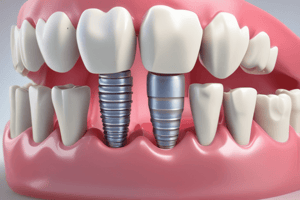Podcast
Questions and Answers
What is the primary benefit of mandibular two-implant overdentures?
What is the primary benefit of mandibular two-implant overdentures?
- Lower treatment costs
- Improved denture retention (correct)
- Reduced dental visits
- Elimination of the need for dentures
Severe bone resorption is a key reason for recommending mandibular two-implant overdentures.
Severe bone resorption is a key reason for recommending mandibular two-implant overdentures.
True (A)
What diagnostic imaging method is typically used to assess available bone for implant placement?
What diagnostic imaging method is typically used to assess available bone for implant placement?
Panoramic radiograph or CT scans
The process of bonding between implant and bone is called __________.
The process of bonding between implant and bone is called __________.
Match the following stages of the mandibular two-implant overdenture process with their descriptions:
Match the following stages of the mandibular two-implant overdenture process with their descriptions:
What abutments are used for the definitive intraoral impression in this procedure?
What abutments are used for the definitive intraoral impression in this procedure?
Patients with existing unsatisfactory dentures may benefit from two-implant overdentures.
Patients with existing unsatisfactory dentures may benefit from two-implant overdentures.
How long is the healing period necessary for osseointegration after implant placement?
How long is the healing period necessary for osseointegration after implant placement?
Flashcards
Mandibular two-implant overdentures
Mandibular two-implant overdentures
A dental restoration using two implants in the mandible to support an overdenture, improving retention, stability, and patient satisfaction, particularly in cases of severe jawbone loss.
Edentulous mandible
Edentulous mandible
A condition of having no teeth in the lower jaw
Bone resorption
Bone resorption
The gradual loss of bone tissue, often occurs in the jaw after tooth loss, leading to decreased jawbone support.
Diagnostic casts
Diagnostic casts
Signup and view all the flashcards
Custom trays
Custom trays
Signup and view all the flashcards
Implant placement
Implant placement
Signup and view all the flashcards
Osseointegration
Osseointegration
Signup and view all the flashcards
Healing abutments
Healing abutments
Signup and view all the flashcards
Locator abutments
Locator abutments
Signup and view all the flashcards
Treatment plan
Treatment plan
Signup and view all the flashcards
Study Notes
Implant Laboratory Procedures
- Mandibular two-implant overdentures improve denture retention, stability, and patient satisfaction, especially in cases of significant mandibular bone resorption.
- Patients often present with unsatisfactory existing dentures with worsened fit, retention, and comfort due to bone resorption.
- Key diagnoses include edentulous maxilla or mandible, severe bone resorption in the mandible, and ill-fitting dentures.
- Clinical exam reveals significant mandibular ridge resorption.
- Radiographic imaging (e.g., panoramic radiographs or CT scans) assesses available bone for implant placement.
- A treatment plan considers two implants for overdenture retention, or multiple implants for a fixed prosthesis.
Procedure Overview
- Diagnostic Casts: Well-extended alginate impressions create diagnostic casts accurately representing the patient's anatomy for surgical and prosthetic planning.
- Custom Impression Trays: Custom trays precisely capture implant sites and adjacent tissue impressions, ensuring accurate prosthesis fit.
- Implant Placement: Two implants are placed in the anterior mandible between the mental foramina, guided by patient anatomy and bone structure.
- Healing and Osseointegration: A healing period (e.g., 12 weeks) allows for implant osseointegration (bone bonding). Healing abutments are positioned to shape the soft tissue surrounding the implants.
- Definitive Intraoral Impression: After osseointegration, a definitive impression is taken utilizing Locator abutments (specifically for overdenture retention). These abutments provide resilience and ease of use.
- Master Cast and Occlusion Records: A master cast is produced from the definitive impression; record bases and occlusion rims are constructed to determine the future prosthesis's vertical dimension and alignment.
- Wax Denture Try-In: A wax denture is created and tested in the patient's mouth to check fit, aesthetics, and function.
- Final Denture Processing and Insertion: The final overdenture is processed, adjusted, and securely attached to the Locator abutments.
Follow-Up and Maintenance
- Locator attachments are commonly used because of their durability and ease of maintenance. They provide a stable connection between the denture and implants, enabling comfortable speaking, eating, and smiling.
- Regular follow-up appointments monitor implant/prosthesis health. Attachments might require replacement over time due to wear; however, implant-supported overdentures are generally predictable and long-lasting.
Studying That Suits You
Use AI to generate personalized quizzes and flashcards to suit your learning preferences.




